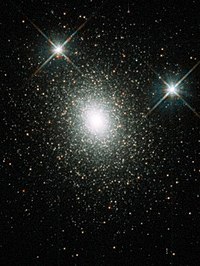
Photo from wikipedia
The brightest fast blue optical transients (FBOTs) are mysterious extragalactic explosions that may represent a new astrophysical phenomenon 1 . Their fast time to maximum brightness of less than a… Click to show full abstract
The brightest fast blue optical transients (FBOTs) are mysterious extragalactic explosions that may represent a new astrophysical phenomenon 1 . Their fast time to maximum brightness of less than a week, decline over several months, and atypical optical spectra and evolution are difficult to explain within the context of the core collapse of massive stars, which are powered by radioactive decay of 56 Ni and evolve more slowly 2 , 3 . AT2018cow (at a redshift of 0.014) is an extreme FBOT in terms of rapid evolution and high luminosity 4 – 7 . Here we present evidence for a high-amplitude quasiperiodic oscillation of AT2018cow’s soft X-rays with a frequency of 224 Hz (at a 3.7 σ significance level or false alarm probability of 0.02%) and fractional root-mean-squared amplitude of >30%. This signal is found in the average power density spectrum taken over the entire 60-day outburst and suggests a highly persistent signal that lasts for a billion cycles. The high frequency (rapid timescale) of 224 Hz (4.4 ms) argues for a compact object in AT2018cow, which could be a neutron star or black hole with a mass less than 850 solar masses. If the quasiperiodic oscillation is equivalent to the spin period of a neutron star, we can set limits on the star’s magnetic field strength. Our work highlights a new way of using high-time-resolution X-ray observations to study FBOTs. A high-frequency quasiperiodic oscillation in the soft X-rays from unusual transient AT2018cow points towards the presence of a compact object in the remnant: either a neutron star with spin period of 4 ms or a low-mass black hole.
Journal Title: Nature Astronomy
Year Published: 2021
Link to full text (if available)
Share on Social Media: Sign Up to like & get
recommendations!